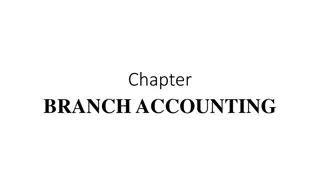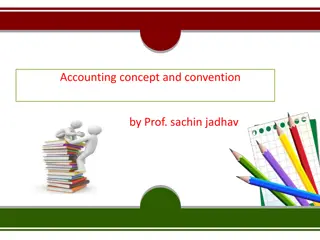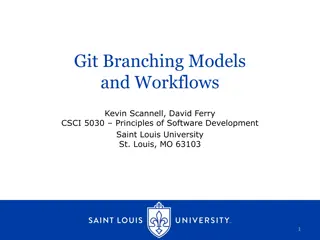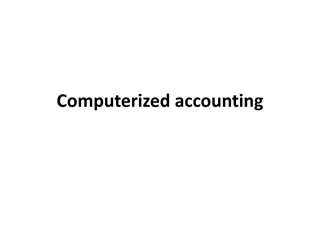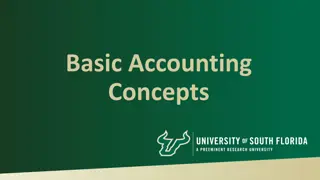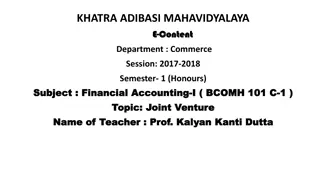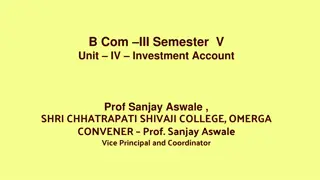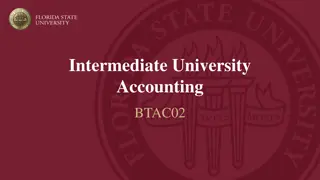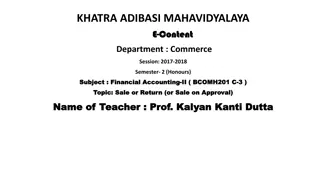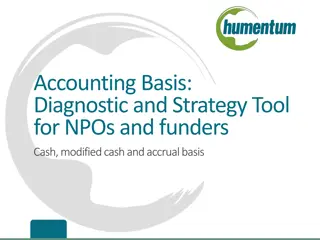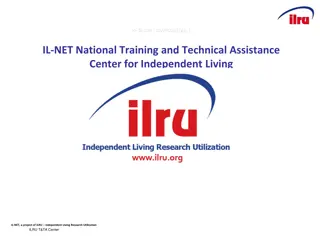Accounting for Independent Branches: Salient Features and Transactions
Independent branches maintain separate sets of accounts and carry out business transactions autonomously. The accounting system of an independent branch involves double entry bookkeeping, reconciliation of accounts between the branch and head office, and recording transactions like dispatch of goods, returns, expenses, purchases, sales, and asset management.
Download Presentation

Please find below an Image/Link to download the presentation.
The content on the website is provided AS IS for your information and personal use only. It may not be sold, licensed, or shared on other websites without obtaining consent from the author. Download presentation by click this link. If you encounter any issues during the download, it is possible that the publisher has removed the file from their server.
E N D
Presentation Transcript
WELCOME WELCOME B.Com Part Class: Class: B.Com Subject: Financial Accounting Subject: Financial Accounting Topic: Branch Accounts Topic: Branch Accounts Accounting for Independent Branches Accounting for Independent Branches Part- -1 1 Prepared By Dr. SHAHID IQBAL Guest Faculty Marwari College, Darbhanga, Mobile No. and Whatsup No. : 7004160257 Email ID: shahidlnmu@gmail.com 1
Independent Branch Meaning: A branch is said to be independent when it maintains a separate set of books of accounts and keeps a full system of accounting. In other words, the branch carries on business as an independent unit, records all the transactions in its own books, extracts its own Trial Balance and prepares its own Trading and Profit and Loss Account. A copy of the Trial Balance so prepared will be forwarded to the head office and the head office will incorporate the same in its books of accounts so that a consolidated Profit and Loss Account and a Balance Sheet can be prepared for the business as a whole. Independent branches generally do not depend upon the head office for supplies of goods and for meeting the expenses and they are not required to remit their collections to the head office daily as in the case of dependent branches. However, periodical transfer of goods and remittance of money may take place between the head office and the branch. 2
Salient features of accounting system of an independent branch are as follows: 1. Branch maintains its entire books of account under double entry system. 2. Branch opens in its books a Head Office account to record all transactions that take place between Head Office and branch. The Head Office maintains a Branch account to record these transactions. 3. Branch prepares its Trial Balance, Trading and profit and loss Account at the end of the accounting period and sends copies of these statements to Head Office for incorporation. 4. After receiving the final statements from branch, Head Office reconciles between the two Branch account in Head Office books and Head Office account in Branch books. 5. Head office passes necessary journal entries to incorporate branch trial balance in its books. 3
Transactions Head office books Branch books (i) Dispatch of goods to branch by H.O. Branch A/c To Good sent to Branch A/c Dr. Goods received from H.O. A/c To Head Office A/c Dr. (ii) When goods are returned by the Branch to H.O. Head Office A/c To Goods received from H.O. A/c Dr. Goods sent to Branch A/c Dr. To Branch A/c (iii) Branch Expenses are paid by the Branch Branch Expenses paid by H.O. No Entry Expenses A/c To Bank or Cash A/c Dr. (iv) Branch A/c To Bank or cash No Entry Dr. Expenses A/c To Head Office A/c Dr. (v) Outside purchases made by the Branch Purchases A/c To Bank (or) Creditors A/c Dr. No Entry (vi) Sales effected by the Branch Cash or Bank A/c Dr. To Branch A/c Cash or Debtors A/c To Sales Dr. (vii) Collection from Debtors of the Branch recd. by H.O. Branch A/c To Bank A/c Dr. Head office A/c To Sundry Debtors A/c (viii) Payment purchase made by Branch by H.O. for Purchases/Sundry Creditors To Head Office A/c No Entry Sundry Assets To Bank (or) Liability Dr. (ix) Purchase of Asset by Branch Branch Asset A/c Dr. To Branch A/c Head office To Bank (or) Liability Dr. (x) Asset purchased by the Branch but Asset A/c retained at H.O. books 4
Transactions Head office books Branch books (xi) Depreciation on (x) Above Branch A/c Dr. To Branch Asset Depreciation A/c To Head Office A/c Dr. (xii) Remittance of funds by H.O. to Branch Branch A/c Dr. To Bank Bank A/c To Head Office Dr. Reverse entry of(xii) above Reverse entry of(xii) above Remittance of funds by (xiii) Branch to H.O. Supplying Branch H.O. A/c Dr. To Goods Received from H.O. A/c (Recipient) Branch A/c Dr. To Supplying Branch A/c (xiv) Transfer of goods From one Branch another branch to Recipient Branch Goods Received from H.O. A/c Dr. To Head Office A/c 5
In Transit Items When both branch and head office trial balance are given in the question, the balance shown by the head office account in the branch trial balance and the balance as shown by the branch account in the head office trial balance normally tally. However, it may not be so, then the following accounts of branch trial balance must be reconciled with the accounts of head office trial balance. 1. Goods-in-transit : When the head office may have sent goods to the branches, these goods may have not been received by the end of the accounting year by the branch. It is called as goods-in-transit. Thus, goods-in-transit is an asset to the head office. For example if Head Office has sent goods worth ` 50,000 but the branch has received till the closing date goods only ` 40,000, then the branch should treat ` 10,000 as goods in transit and should pass the following entry : Goods in transit A/c Dr. To Head Office A/c 10,000 However, there will be no entry in Head office books being the point where the event has been recorded in full, hence no further entries in Head office books. 10,000 2. Cash-in-Transit : When the branch may have sent cash to the head office, the amount may have not been received by the head office by the end of the accounting period. If is called as cash-in-transit. Thus, cash-in-transit is an asset to the branch. 6
Inter-Branch Transactions Inter-branch transactions are usually adjusted as if they were entered into only with the head office. It is a very convenient method of treating such transaction especially where the number of branches are large. Suppose Kolkata Branch incurred an expenditure on advertisement of ` 1,000 on account of Delhi Branch, the entries that would be made in such a case would be as follows: Dr. Cr. In Kolkata Books: Head Office A/c To Cash In Delhi Books: Advertisement A/c To H.O. A/c In H.O. Books: Delhi Branch A/c To Kolkata Branch A/c Dr. 1,000 1,000 Dr. 1,000 1,000 Dr. 1,000 1,000 7
INCORPORATION OF BRANCH BALANCE IN HEAD OFFICE BOOKS: The method that will be adopted for incorporating the trading result of the branch with that of the head office would depend on whether it is desired to prepare separate Profit & Loss Account and Balance Sheet of the branch and the Head Office or consolidated statement of account of both branch and head office. In the first-mentioned case, the amount of profit or loss shown by the Profit & Loss Account of the branch only will be transferred to Head office Account in the branch books and a converse entry will be passed in the Head Office books by debit to the Branch Account. This method has already been illustrated above. In such a case, not only the Profit & Loss Account of the branch and that of the head office would be prepared separately but also there would be separate Balance Sheet for the branch and the head office. The branch Balance Sheet would show the amount advanced by the head office to it, as capital. In the head office Balance Sheet, the same amount would be shown as an advance to the branch. If however, it is desired to prepare a consolidated Profit & Loss Account and Balance Sheet, individual balances of all the revenue accounts would be separately transferred to the Head Office Account by debit or credit in the branch books and the converse entries would be passed in the head office books. The effect thereof will be similar to the amount of net profit or loss of the branch having been transferred since it would be composed of the balances that have been transferred. 8
In case it is also desired that consolidated balance sheet of the branch and the head office should be prepared, it will also be necessary to transfer the balance of assets and liabilities of the branch to the head office. The adjusting entries that would be passed in this respect are shown below: a) Head Office Account To Asset (individual) Account (Individual) Liability Account Dr. To Head Office Account Dr. b) Converse entries are passed in the head office books. It is obvious that after afore-mentioned entries have been passed, the Branch Account in the Head Office books and Head Office Account in the branch books will be closed and it will be necessary to restart them at the beginning of the next year. In consequence, at the beginning of the following year, the under-mentioned entry is recorded by the branch: Asset Account (In Detail) To Liability Accounts (In Detail) To H.O. Account (The difference between assets and liabilities) Dr. 9
Thank You 10


